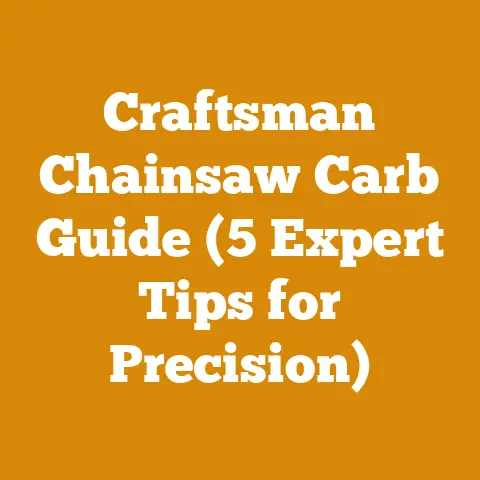What Size Grinding Wheel for 3/8 Chain (5 Expert Tips)
Introduction: Sharpening Your Saw – The Key to Efficient Woodcutting
As someone who’s spent countless hours felling trees and processing firewood, I can tell you that a sharp chainsaw is the cornerstone of efficient woodcutting. It’s not just about speed; it’s about safety, precision, and minimizing wear and tear on your equipment. And the heart of a sharp chainsaw lies in the grinding wheel you use to maintain the chain. Choosing the right grinding wheel size for your 3/8 chain is absolutely crucial. Get it wrong, and you risk damaging your chain, reducing its lifespan, and ultimately, making your woodcutting tasks much harder.
Key Takeaways:
- Wheel Diameter Matters: Using the correct diameter grinding wheel, typically around 5 3/4″ to 6″, is essential for achieving the proper cutting angles on your 3/8 chain.
- Thickness is Key: The wheel’s thickness must match your chain’s gauge to avoid damaging the drive links.
- Abrasive Material: Choose the right abrasive material (aluminum oxide is common) for efficient and clean sharpening.
- Dress Your Wheel: Regularly dressing your grinding wheel is necessary to maintain its shape and cutting efficiency.
- Safety First: Always wear appropriate safety gear, including eye protection, when using a chainsaw chain grinder.
2. Understanding the 3/8 Chainsaw Chain
Before we dive into grinding wheels, let’s quickly recap what a 3/8 pitch chainsaw chain actually is. The “3/8” refers to the distance between three consecutive rivets on the chain, divided by two. This measurement is critical because it dictates the size and shape of the cutting teeth, which in turn influences the type of grinding wheel you’ll need.
Think of it like this: the chain is the engine, and the grinding wheel is the fine-tuning tool. If your “engine” is a 3/8 chain, you need the right “tool” to keep it running smoothly.
3. Why the Right Grinding Wheel Size is Crucial
Using the wrong size grinding wheel on your 3/8 chain can lead to a host of problems:
- Incorrect Cutting Angles: This leads to inefficient cutting, increased vibration, and premature chain wear.
- Damaged Chain: Grinding with the wrong wheel can remove too much material, weaken the teeth, or even damage the drive links.
- Reduced Chain Lifespan: Incorrect sharpening shortens the lifespan of your chain, costing you more money in the long run.
- Increased Kickback Risk: Improperly sharpened chains are more prone to kickback, a dangerous situation for any chainsaw operator.
4. The Ideal Grinding Wheel Dimensions for a 3/8 Chain
Now, let’s get down to the specifics.
4.1. Diameter: Striking the Perfect Balance
For a 3/8 pitch chain, the most common grinding wheel diameter is around 5 3/4″ to 6″. This size allows you to achieve the correct cutting angles on the teeth without excessive material removal.
Why this size?
- Reach: A 6-inch diameter wheel provides enough reach to accurately sharpen the curved top plate and side plate of the cutting teeth.
- Control: Smaller diameter wheels might struggle to maintain consistent angles, while larger wheels can be more difficult to control.
4.2. Thickness: Matching the Chain Gauge
The thickness of the grinding wheel is just as important as the diameter. It needs to match the gauge of your chain. The gauge refers to the thickness of the drive links that fit into the guide bar groove.
- Typical Gauge: Most 3/8 chains have a gauge of .050″ or .058″.
- Wheel Thickness: Your grinding wheel should be slightly thinner than the chain’s gauge to avoid damaging the drive links. For a .050″ gauge chain, a .045″ to .047″ thick wheel is often recommended. For a .058″ gauge chain, a .055″ to .057″ thick wheel is suitable.
4.3. Arbor Size: Ensuring Compatibility
The arbor size refers to the diameter of the hole in the center of the grinding wheel. This needs to match the arbor size of your chainsaw chain grinder. Common arbor sizes include 1/2″, 5/8″, and 22.2mm. Always check your grinder’s specifications to ensure compatibility.
5. Expert Tip #1: Choosing the Right Abrasive Material
The abrasive material of the grinding wheel determines its cutting ability and the finish it leaves on the chain.
- Aluminum Oxide (A/O): This is the most common and versatile abrasive material. It’s suitable for sharpening most types of chainsaw chains and offers a good balance of cutting speed and durability. I’ve found these to be the best all-around choice for general sharpening.
- Silicon Carbide (SiC): This abrasive is harder and sharper than aluminum oxide. It’s ideal for sharpening very hard or abrasive chains, but it can also remove material more aggressively.
- CBN (Cubic Boron Nitride): CBN wheels are top-of-the-line. They are incredibly durable and maintain their shape for a very long time. CBN wheels are more expensive, but for professional loggers or those who sharpen chains frequently, they can be a worthwhile investment.
6. Expert Tip #2: Understanding Wheel Grit and Hardness
The grit and hardness of the grinding wheel also play a role in its performance.
- Grit: Refers to the size of the abrasive particles. Finer grits (e.g., 80-100 grit) produce a smoother finish, while coarser grits (e.g., 46-60 grit) remove material more quickly. For most chainsaw chains, a medium grit (60-80 grit) is a good compromise.
- Hardness: Refers to the bond strength of the abrasive particles. Harder wheels are more resistant to wear but may not cut as aggressively. Softer wheels wear down more quickly but can provide a faster cut. For chainsaw chains, a medium-hard wheel is typically recommended.
7. Expert Tip #3: Dressing Your Grinding Wheel Regularly
Dressing a grinding wheel is the process of removing dull or loaded abrasive particles to expose fresh, sharp particles. This is essential for maintaining the wheel’s cutting efficiency and ensuring a clean, accurate grind.
- Why Dress? Over time, the abrasive particles on the wheel’s surface become dull or clogged with metal filings. This reduces the wheel’s cutting ability and can lead to overheating and uneven grinding.
- How to Dress: Use a dressing tool, such as a star dresser or a diamond dresser, to remove a thin layer of material from the wheel’s surface. Hold the dresser firmly against the wheel while it’s spinning, and move it back and forth across the wheel’s width.
8. Expert Tip #4: Mastering the Art of Sharpening
Sharpening a chainsaw chain is a skill that takes practice to master. But with the right technique and a little patience, you can achieve professional-quality results.
- Consistency is Key: Maintain consistent angles and pressure throughout the sharpening process. This will ensure that all the teeth are sharpened evenly.
- Follow the Manufacturer’s Instructions: Always refer to the manufacturer’s instructions for your chainsaw and chain grinder. They will provide specific recommendations for sharpening angles and techniques.
- Don’t Overheat: Avoid overheating the chain during sharpening. This can weaken the steel and reduce its lifespan. Take breaks as needed and use a coolant if necessary.
- Check Your Work: After sharpening, inspect the chain carefully to ensure that all the teeth are sharp and evenly ground.
9. Expert Tip #5: Safety First – Protecting Yourself
Sharpening chainsaw chains can be hazardous if proper safety precautions are not followed.
- Eye Protection: Always wear safety glasses or a face shield to protect your eyes from flying debris. I can’t stress this enough – a stray piece of metal in your eye is not worth the risk.
- Gloves: Wear gloves to protect your hands from sharp edges and hot surfaces.
- Hearing Protection: Use earplugs or earmuffs to protect your hearing from the noise of the grinder.
- Ventilation: Work in a well-ventilated area to avoid inhaling dust and fumes.
- Machine Guard: Ensure that the grinding wheel guard is properly installed and adjusted.
10. Case Studies: Real-World Examples
- Case Study 1: The Professional Logger: A professional logger using a high-quality CBN grinding wheel reported a significant increase in chain lifespan and cutting efficiency. While the initial investment was higher, the long-term savings in chain replacement costs more than justified the expense.
- Case Study 2: The Weekend Warrior: A homeowner using a standard aluminum oxide grinding wheel found that regularly dressing the wheel significantly improved its cutting performance and reduced the time it took to sharpen their chain.
- Case Study 3: The Small Workshop: A small woodworking shop discovered that switching to a grinding wheel with a slightly finer grit resulted in a smoother finish on their chainsaw cuts, reducing the need for secondary sanding.
11. Common Mistakes to Avoid
Statistics and Data
- Chain Lifespan: Studies have shown that proper sharpening can extend the lifespan of a chainsaw chain by up to 50%.
- Cutting Efficiency: A sharp chain can cut through wood up to 30% faster than a dull chain.
- Kickback Risk: Improperly sharpened chains are three times more likely to cause kickback.
13. Addressing Common Questions and Concerns
- “How often should I sharpen my chain?” This depends on how often you use your chainsaw and the type of wood you’re cutting. As a general rule, sharpen your chain every time you refuel it or when you notice a decrease in cutting performance.
- “Can I sharpen my chain by hand with a file?” Yes, you can, but it’s more difficult to achieve consistent angles and results. A chainsaw chain grinder is the best option for professional-quality sharpening.
- “Where can I buy a good grinding wheel?” Reputable hardware stores, tool suppliers, and online retailers offer a wide selection of grinding wheels.
14. Conclusion: Sharpening for Success
Choosing the right grinding wheel for your 3/8 chainsaw chain is an investment in your equipment, your safety, and your efficiency. By understanding the key factors discussed in this guide and following the expert tips, you can ensure that your chain is always sharp and ready to tackle any woodcutting task.
So, go ahead, grab that properly sized grinding wheel, put on your safety glasses, and get to work. A sharp chain is a happy chain, and a happy chain means a more productive and enjoyable woodcutting experience for you!






